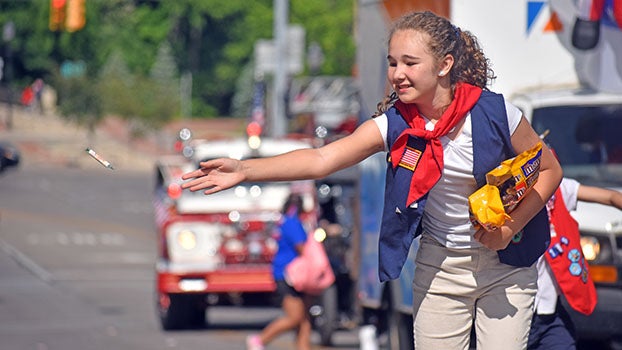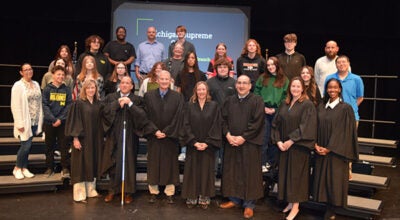Brains still wired for stories
Published 8:54 pm Thursday, February 2, 2012

Sister Lakes students react Wednesday to story artist Jenifer Strauss of Traverse City. She taught parents “Band-Aid” stories, arranging narratives on her fingers. “It’s important to be silly with our kids and to sing, dance and move.”
At birth, babies’ brains are only 17 percent “wired.”
Everything an infant hears, sees, feels, smells or tastes goes toward developing that other 83 percent.
With school-age children logging 44.5 hours a week — equivalent to a full-time job — at a screen, technology can be a mixed blessing.
Children should hear 300,000 words before they start school to become proficient readers later.
Language can come from daily conversation, songs, pictures, stories and games.
It takes more energy after jobs, dinner and homework to share stories aloud than to flop in front of a television.
Vocabulary could be represented as an inverted pyramid, with speaking at the wide opening, reading in the tapering middle and writing at the tip.
The more storytelling children hear, the better at reading and writing they become.
Jenifer Strauss, the Traverse City story artist who returned to Sister Lakes Elementary School Wednesday for Family Learning Night that replaced the Parent Fair, started as an environmental educator.
Then she taught 10 years — second grade two years, sixth-graders the rest — until she convinced herself story is most powerful because that’s how the human brain is wired.
“For generations before we wrote anything down, this is how we shared our lives with each other,” Strauss said. “Every culture had a story that told customs, how to behave, how to take care of grandparents. Everything changed when we finally got to a place where we had written print, but our brains are still wired for story. The brain’s pre-frontal cortex I call the movie projector because it lets us ‘see’ things vividly in our imaginations. Everything that happens to us is a story.”
The Detroit native has been “touring and telling” since 1993, preaching to Sister Lakes parents that if they can tell a story, they can write a story.
Using simple props such as snake soccer sock puppets and a turtle made from a shoulder pad, Strauss demonstrated ways to connect with children, from “Band-Aid stories” to using fingers (where you were, what happened to need a bandage, who came to help and what you learned) to organize narrative elements.
Strauss, cutting a Mother’s Day tulip bouquet, managed to leave scissors “protruding from my knee. Blood gushed out of the cut, cascaded down my leg between my toes and puddled on the bathroom floor.”
Strauss’s late mother masterfully redirected third grade summer boredom into an “adventure box” that turned her from a poor writer to a pumped-up one by fourth grade.
Jen was directed to each day try something she had never done before without getting in trouble or hurt.
“Bring me something home each night and I’ll try to guess what you did.”
A pine cone came from building a tree fort. A peanut shell from feeding circus elephants. A Band-Aid went into her box.
Mom so enjoyed hearing her tales, she asked her daughter to write them down — 22 in all.
As a teacher on summer vacation, she strapped a canoe on top of her truck and paddled in Canada “like a fur trader.” Another summer she rode her bike across the Mackinac Bridge into the Upper Peninsula.
Camping “in a different place every night,” Strauss found herself in Ahmeek, a mostly boarded-up copper mining village in Keweenaw County on Lake Superior.
A dimly lit antique store was about all that was open. She bought a lantern almost 150 years old from a balding, pot-bellied proprietor wearing saggy blue jeans, reading glasses balanced precariously on his nose. It belonged to a Finnish family with seven kids “tumbling down the steps” to share stories around it, as she has since 1987.
Sister Lakes for several years has had its own troupe of student storytellers, according to Title I teacher Debora Barber. Debbie Loyd still returns from retirement to help coach.






